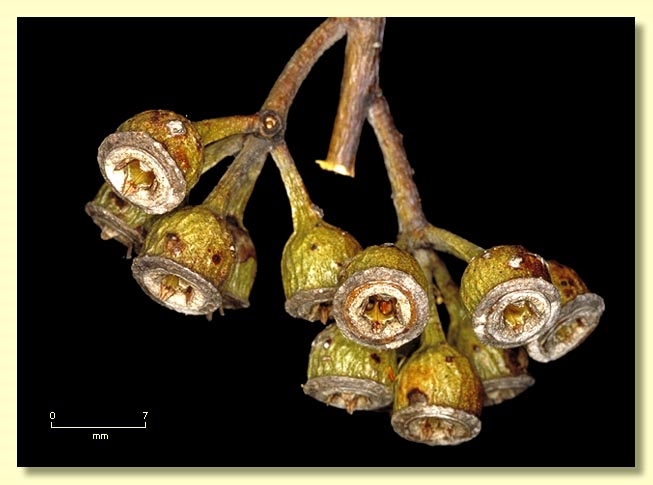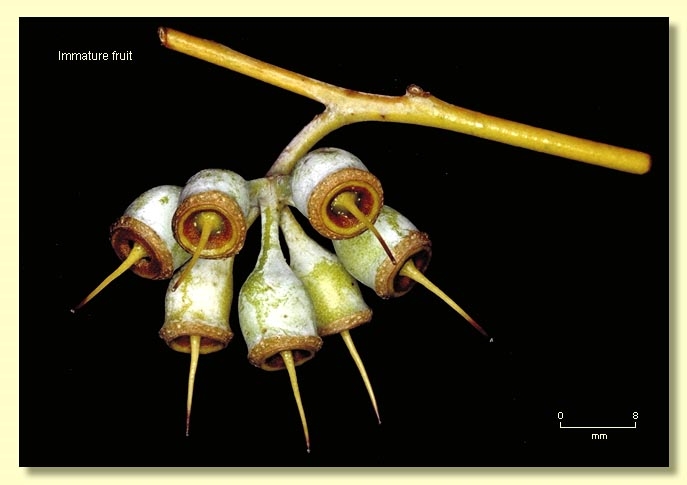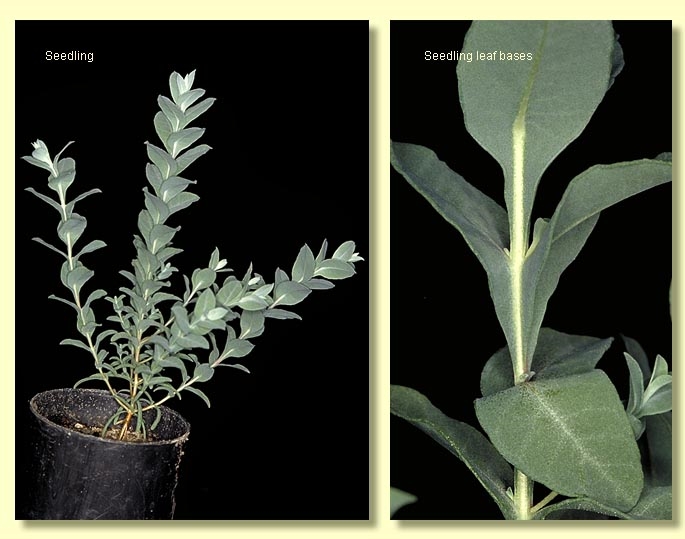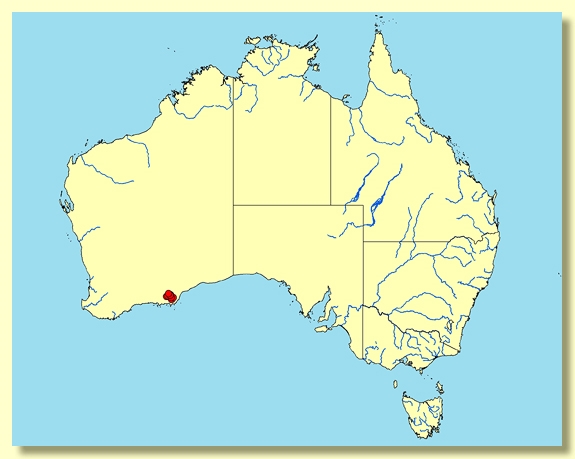Eucalyptus | Symphyomyrtus | Bisectae | Destitutae | Subulatae | Decurrentes
Euclid - Online edition
Eucalyptus luculenta
Bark smooth throughout, grey to white to pink.
Branchlets glaucous; lacking oil glands in the pith.
Juvenile growth (coppice or field seedlings to 50 cm): stems square in cross-section, appearing winged due to decurrent leaf bases, becoming round further up the stem, slightly glaucous to non-glaucous; juvenile leaves opposite, sessile with decurrent bases on lower stem then alternate, sessile to shortly petiolate with leaf bases tapering to the petiole, broadly lanceolate, 6–15 cm long, 2.5–4.5 cm wide, dull, grey-green to green.
Adult leaves alternate, petiole 1.4–4 cm long; blade lanceolate to broadly lanceolate to ovate, 6–16 cm long, 1.5–3.5(4.5) cm wide, base tapering to petiole, rarely rounded, concolorous, dull, grey-green to green, side-veins at an acute or wider angle to midrib, moderately to densely reticulate, intramarginal vein parallel to and 1–3 mm within margin, oil glands numerous and mostly intersectional.
Inflorescence axillary unbranched, peduncles 0.7–1.4 cm long, erect to pendulous; buds 7, pedicellate, pedicels 0.4–1 cm long. Mature buds ± ovoid to oblong to pyriform (1.4–1.9 cm long, 0.6–0.9 cm wide), usually glaucous (rarely non-glaucous), scar present, operculum finely beaked (0.9–1.4 cm long), wider than the hypanthium at the join, stamens mostly inflexed or irregularly flexed, anthers versatile, basifixed, globoid, dehiscing by slits, style long, stigma tapered, locules 3 or 4, the placentae each with 4 vertical ovule rows. Flowers pale yellow to white.
Fruit pedicellate (pedicels 0.3–0.8 cm long), cup-shaped to cylindrical to barrel-shaped, rarely slightly urn-shaped, sometimes glaucous, 0.7–1 cm long, (0.6)0.7–0.8(0.9) cm wide, rim thick, disc descending to level, valves 3 or 4, valve tips strongly exserted due to fragile style remnants.
Seeds brown to grey, 1–2 mm long, ovoid or flattened-ovoid, rarely pointed at one end, occasionally with shallow longitudinal furrows on otherwise smooth dorsal surface, hilum ventral.
Cultivated seedlings (measured at node 10): cotyledons Y-shaped (bisected); stems square in cross-section and prominently winged due to decurrent leaf bases, non-glaucous to slightly glaucous; leaves opposite, sessile, linear to oblong for the first 4–5 nodes then ovate, dull, glaucous, 2–2.5 cm long, 1.2–1.5 cm wide, leaf base decurrent on stem.
Flowering has been recorded in October and November.
A smooth-barked mallee endemic to Western Australia where confined to the Mt Ragged area south of Balladonia. It grows in sandy soils. The adult leaves are dull, green to grey-green and the buds and young fruit glaucous.
Eucalyptus luculenta belongs in Eucalyptus subgenus Symphyomyrtus section Bisectae subsection Destitutae because buds have two opercula, cotyledons are Y-shaped and branchlets lack oil glands in the pith. Within this subsection E. luculenta is part of a large taxonomic series (Subulatae) further characterised by globoid basifixed anthers, grey smooth seeds with shallow longitudinal furrows, and fruit with semi-persistent exserted style remnants. Series Subulatae is divided principally into four subseries based on the juvenile leaves, one with spiral, crowded seedling phyllotaxis (subseries Spirales), another with decussate and strongly decurrent seedling leaves (subseries Decurrentes), another with decussate non-decurrent seedling leaves (subseries Decussatae), and a fourth with disjunct, petiolate seedling leaves (subseries Oleaginae).
Eucalyptus luculenta is part of subseries Decurrentes. It is closely related to E. neutra, E. flocktoniae subsp. hebes and E. transcontinentalis. E. luculenta has more robust buds with the operculum wider than the hypanthium, fruit with a thick rim, and larger adult and juvenile leaves, compared with these three taxa. E. transcontinentalis is further distinguished by being a smooth-barked tree, not a mallee.
E. luculenta should not be confused with any other member of the subseries Decurrentes. E. hypolaena and E. moderata are both rough-barked species. E. urna, E. flocktoniae subsp. flocktoniae and E. peninsularis have glossy adult leaves and non-glaucous buds and fruit. E. rhomboidea is a tree and lacks the pronounced beak on the operculum. E. optima is a tree and lacks a lignotuber.















